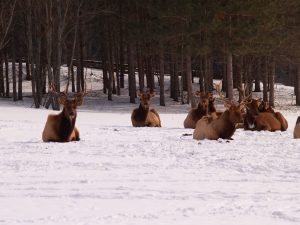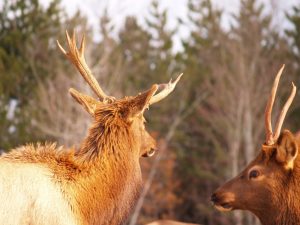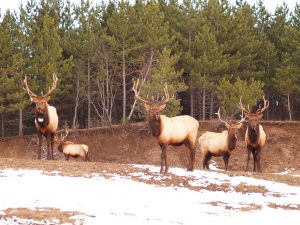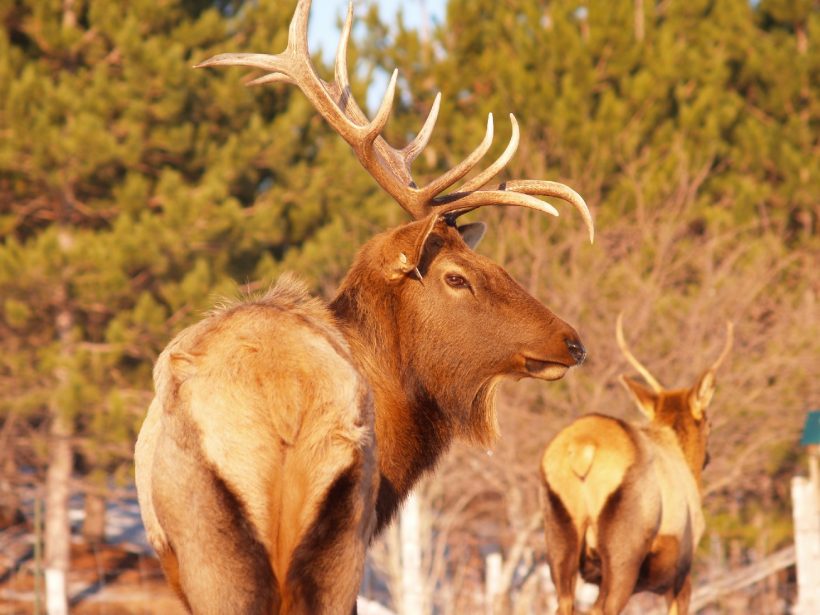Bancroft – RETURN OF THE ELK
Time traveller literature has recorded the presence of earthly elk for some 40,000 years. Apparently, there weren’t a lot of elk roaming North America during the glacial age. However, as the glaciers slurped up water from the oceans a land bridge emerged joining Siberia to Alaska. Theory has it that the red deer, ancestor to the elk, migrated across to North America. As the earth warmed and the glaciers retreated the elk migrated from Alaska in a southward and eastward direction. Enter the Europeans.
As the Europeans expanded westward they killed many elk for food. As they established new settlements the Europeans killed even more elk that were competing for their crops and with their livestock. Human settlement destroyed elk habitat. By the 1900’s two subspecies of elk, the Merriam’s and the Eastern, had gone the way of the Dodo and the remaining four subspecies were approaching the precipice of extinction.
From a population low of 90,000 in the early 1900’s the North American elk herds have grown to some one million animals today with the help of conservationists. One million represents about ten per cent of the elk first present when the Europeans arrived. Today there are wild elk in five Canadian provinces and 24 American states. Readers may have heard their Shawnee Indian name, Wapiti (wap-i-tee) which means “white rump.” Conflicts and wildlife management challenges continue to arise as ever expanding human populations continue to invade elk habitat. The elk lose important feeding habitat to “civilization” and people complain when the elk eat their hay, crops, gardens and shrubs.

A cow elk can weigh as much as 225 kg, stand 1.3 m at the shoulder and measure 2m from nose to tail. The bull can weigh 315 kg, stand 1.5 m and measure 2.4 m nose to tail. A spotted newborn calf weighs 16 kg. Elk are members of the deer family which includes moose, white-tail deer, caribou and mule deer. Body colour varies from a deep copper brown to light tan depending upon the season and location. The rump patch is light beige and the legs and neck often are darker than the body. Antlers can weigh up to 18 kg a pair. Bulls grow them to display dominance, to joust with other bulls and occasionally for defense. Elk squeal, bark, bugle and, like people, communicate via their body language, posture and scent; though I leave the scent part to the reader’s imagination. The elk rut or breeding season is in the fall or autumn (September/October) when the bugling of the bulls can send shivers up the spine. Gestation lasts 8 ½ months. Calves are born mid-May to early July, normally.
Socially cows, calves and yearlings live in loose herds or groups while the bulls do the bachelor thing and either live in groups or alone. “Harems” are made up of cows and calves plus one or two mature bulls. Yearling bulls may form bachelor groups or hang near harems.
Elk needs are pretty much anyone’s needs – food, water, shelter and space. Foods vary with season, availability and location including grasses (spring/fall), woody plants (winter), and grass and forbs (low growing soft stemmed plants) in summer.
Once native to Ontario, elk (Cervus elaphus) were extirpated by the late 1800’s as a result of several factors including commercial and unregulated harvesting, and habitat changes due to human settlement. In the 1930’s and 1940’s the province attempted to restore elk to Ontario. Unfortunately, unfounded concerns that the elk were infecting domestic cattle with giant liver flukes resulted in them being killed whenever possible. However, two small elk herds managed to survive in the Burwash and French River areas.

In 1979, while working towards his MSc studying the Burwash elk, biologist Bruce Ranta orchestrated a mail in post card campaign and brought an end to the elk killing making them a protected species. By 1996 elk in the Nipissing-French River area numbered 50-60 animals. In February 1997, then Minister of Natural Resources Chris Hodgson committed the province to an elk reintroduction program. Ultimately, four areas in Ontario would receive elk: Lake of the Woods, Nipissing-French River, Lake Huron North Shore and Bancroft North Hastings (BNH). In 2000, BNH received its first 70 elk followed by 50 animals in 2001.
The discovery of an elk antler in Limestone Lake, east of Bancroft, ultimately proved that elk were indigenous to the area. Examination of the antler at the University of Toronto’s Iso Trace Radiocarbon laboratory confirmed that the antler dated somewhere between 1435 A.D. and 1525 A.D. (It would be over a century before Champlain would make his Algonquin Highlands appearance.) Coincidentally, this confirmation placed the elk historically at virtually the same location chosen for the elk reintroduction to the Bancroft area.
Elk for this reintroduction program came from Elk Island National Park (EINP), Alberta. EINP operates one of the most rigorous disease management programs in North America in cooperation with the Canadian Food Inspection Agency (CFIA). Individual elk were assessed, sexed and aged, treated for parasites and diseases, ear tagged and fitted with radio collars under the direction of Dr. Rick Rosatte of the Ontario Ministry of Natural Resources (OMNR).
The initial release of the elk at Gin Lake, east of Bancroft, called for a “soft release.” That was THE PLAN. “Soft release” meant the elk would be cared for in a large fenced in area where they would be watered and fed for 4-6 weeks before being released into the wilds. Theory and practice don’t always make for a compatible marriage. The first elk to exit their livestock trailers made a bee-line for the opposite wall and promptly jumped over the 3.048m enclosure. By comparison, a regulation basketball hoop is 3.048m off the ground. To save the elk from any injury volunteers lowered the wall for the remainder of the 70 animals. Fortunately, the winter of 1999/2000 itself proved “soft” –mild winter weather and modest amounts of snowfall- such that the elk wouldn’t have to yard up for survival. They could easily get around to access food and water.
Once again serendipity struck, if such is possible, in 2001, when bad weather precipitated the need for a nocturnal release, the first such for Ontario’s reintroduction program. All went smoothly with the elk exiting their trailers and heading for obscurity on the hemlock ridge at the back of the compound. This “soft release” released the elk from their compound 14 weeks to the day on Saturday April 14. Like cattle exiting the barn for the first time in spring the elk bounced about like a bunch of kids, kicking heels high and gamboling about.

During the intervening years the elk population has blossomed from 120 to presently exceed 300. They have ranged as far away as Quebec, Algonquin Park, Peterboro and Belleville. Since their arrival, numerous elk university studies have taken place and are still ongoing. Elk eco tours have slowly begun to evolve as increasingly people travel to the area in hopes of seeing these majestic animals. To the east of Bancroft tour routes travel the back roads north or south of McArthurs Mills off highway #28. Off highway 62 south of Bancroft routes fan out from the Upper Turriff Road and further south, east from Bannockburn. Free ranging wild elk are yet another bonus for wildlife viewing in the North Hastings area.
